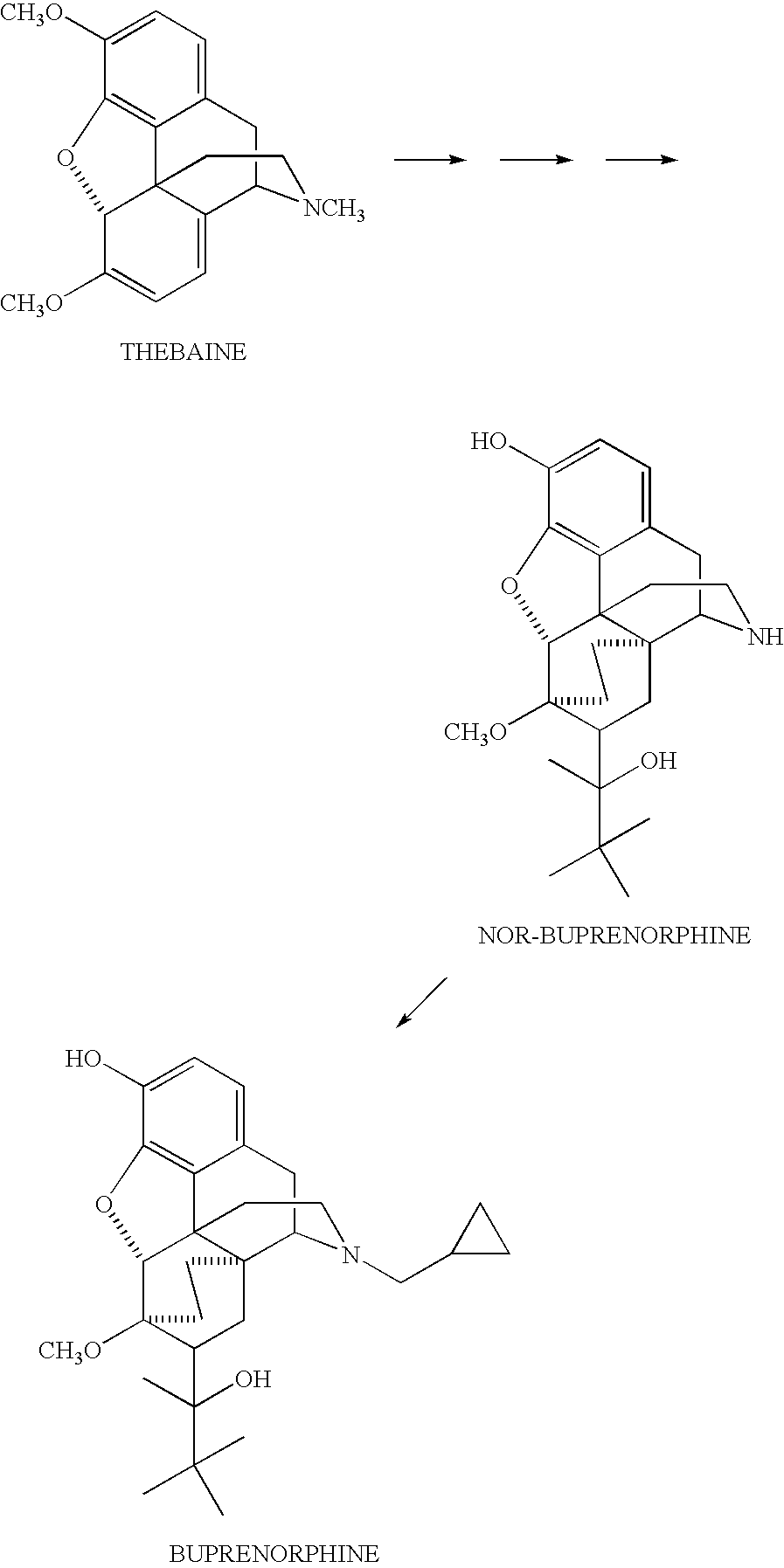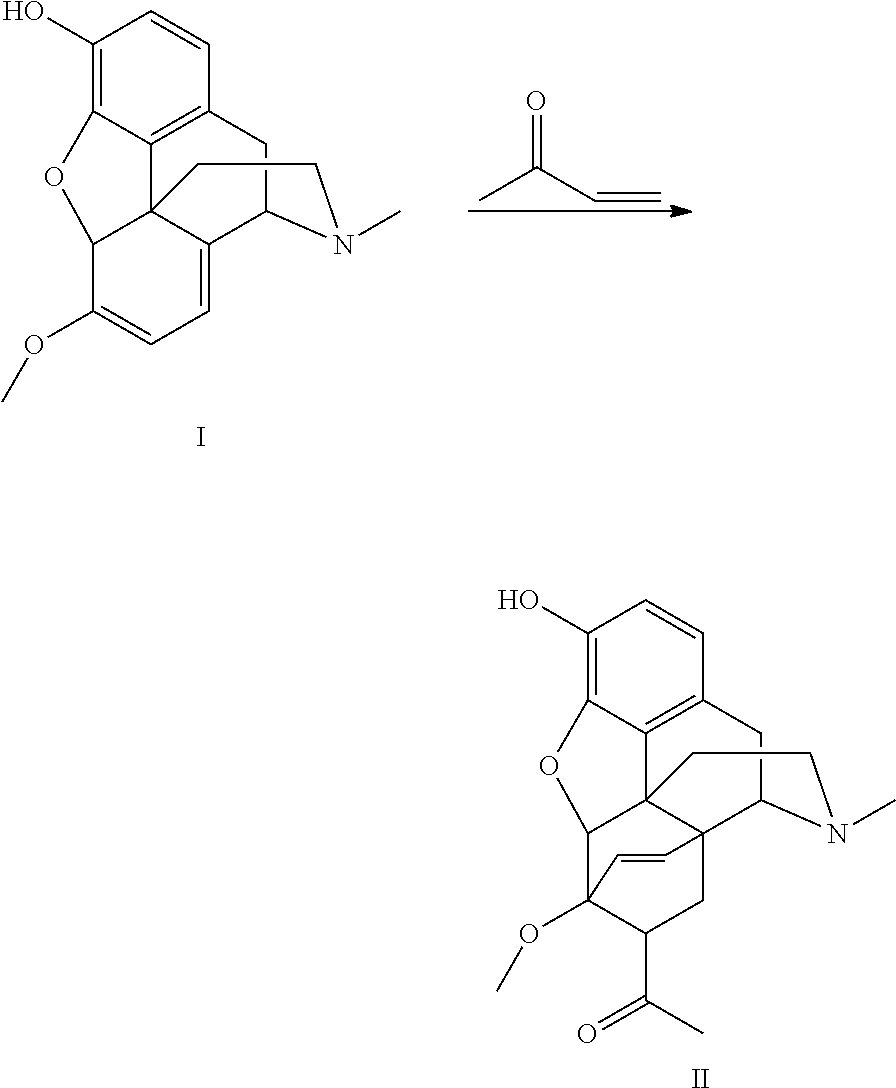Use of oripavine as a starting material for buprenorphine
a buprenorphine and oripavine technology, applied in the field of using oripavine as a starting material for buprenorphine, can solve the problem that the o-demethylation step is considered a low to moderate yield transformation
- Summary
- Abstract
- Description
- Claims
- Application Information
AI Technical Summary
Benefits of technology
Problems solved by technology
Method used
Image
Examples
example 1
[0063]
[0064]The oripavine (150 g, 505 mmol) was charged to a 1-L 3-neck jacketed flask equipped with a mechanical stirring device, a thermocouple, and a reflux condenser. The reactants were dissolved in 750 mL of isopropyl alcohol (IPA), equivalent to 5 mL / g. 90% technical grade methyl vinyl ketone (MVK) was added in two portions. Each portion consisted of 68.0 mL (747 mmol, 1.5 equivalents), with the second addition occurring approximately 8 hours after the first. After the first addition of MVK, the reaction mixture was heated to reflux at about 78° C., and the temperature was slowly increased to near 84° C. as the MVK was consumed. The reaction was allowed to continue overnight after the second addition of MVK, and was stopped in the morning by slowly cooling to 5-10° C. After stirring for approximately 2 hours at 5-10° C., the reaction mixture was filtered to isolate the solids, washing with cold IPA. After drying, an 85% yield of adduct with a purity of 98-99% by area after cor...
example 2
[0065]
[0066]a) A pressure vessel was charged with 9 g (77% assay) of oripavine, 5.6 ml of methyl vinyl ketone and 45 ml of isopropyl alcohol. The vessel was sealed and the contents were heated to 110° C. resulting in a pressure of 35 psi. After 4 hours the reaction mixture was cooled to room temperature and 0.6 g of Pd—C (10%) was added. The mixture was hydrogenated at 70° C. and 40 psi for 24 hours. The product was solubilized using methanol, and the catalyst was removed by filtering through a plug of hyflo. The filtrate was concentrated in vacuo to afford 8.6 g.
example 3
[0067]
[0068]The Diels-Alder adduct (13 g, 35 mmol) formed in Example 1 was charged to a reaction vessel with a 5% charge (dry basis) of 10% Pd / Carbon catalyst (1.3 g). The adduct was then dissolved / suspended in 10 ml / g of methanol (130 mL). After flushing the vessel eight times with 40 psi N2, and four times with 40 psi H2, the pressure was returned to 40 psi H2. The temperature was elevated to 60° C. where the hydrogenation was carried out over approximately eight hours in a Parr-Shaker. Upon complete consumption of the starting material, the vessel was flushed with N2 to purge any remaining H2. The reaction mixture was then filtered as a warm solution through a plug of celite to remove the catalyst. The filtrate was then reduced under vacuum to yield 12.9 g (99%) of the expected product.
PUM
| Property | Measurement | Unit |
|---|---|---|
| pressure | aaaaa | aaaaa |
| pressure | aaaaa | aaaaa |
| temperature | aaaaa | aaaaa |
Abstract
Description
Claims
Application Information
 Login to View More
Login to View More - R&D
- Intellectual Property
- Life Sciences
- Materials
- Tech Scout
- Unparalleled Data Quality
- Higher Quality Content
- 60% Fewer Hallucinations
Browse by: Latest US Patents, China's latest patents, Technical Efficacy Thesaurus, Application Domain, Technology Topic, Popular Technical Reports.
© 2025 PatSnap. All rights reserved.Legal|Privacy policy|Modern Slavery Act Transparency Statement|Sitemap|About US| Contact US: help@patsnap.com



